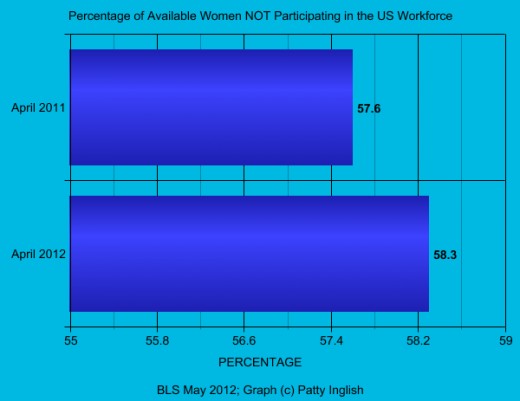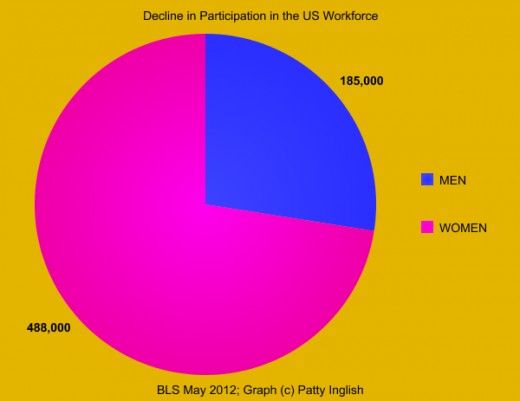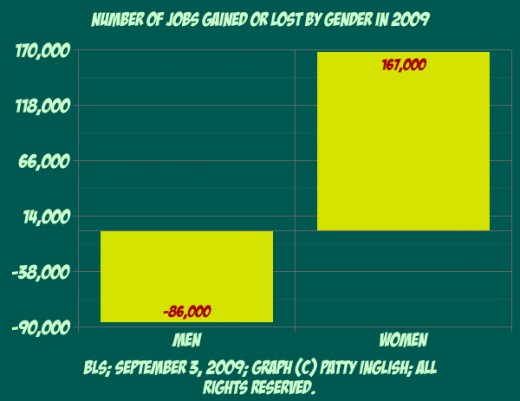US Employment History: More Women Leaving the Workforce than Men
Decline in Female Participation In the US Workforce Year to Date

HubPages Question in May 2012:
Are Men Losing Their Jobs to Women Who Will Work for Less?
Short answer:
- No. As of May 2012, more women than men lost jobs overall in 2012.
- A larger percentage of women available for work in the US but NOT working increased from 2011 to 2012, as shown in the graph above.
- Men also suffered a net loss in jobs, but much fewer than half that for women and a larger proportion of men were lost to retirement, death, military service, and incarceration than women.
- Generally from January - April 2012, more women were leaving the US workforce by layoff, quitting, or not entering the workforce.
- Equal pay acts were signed into law in 1963 and 2009. Whether they are enforced across the USA is in question.
Equal Pay Acts of 1963 and 2009
- The Equal Pay Act of 1963 (EPA)
The Equal Pay Act (EPA) of 1963 made it illegal for employers to pay women less per hours than men for the same work. - Lilly Ledbetter Fair Pact Act of 2009
The major provision of the Fair Pay Act prohibits wage discrimination based on sex, race, or national origin among employees for work in "equivalent jobs."
Workers Lost From US Workforce by Gender, January - April 2012

Fewer Women Were Working January - May 2012
Despite the ongoing debate concerning gender equality and equal pay in the workforce being an unmet goal, and despite debate that men - allegedly most often white men - lost their jobs to women in the 2010s because women earn less money per hour for the same jobs, Bureau of Labor Statistics (BLS.gov) showed otherwise in Quarters 1 and 2 of 2012.
Most markedly in March and April 2012, BLS statistics showed a decrease of women in the workplace. This included all women over the age of 16 that were not institutionalized in some way or serving in the US military branches.
Moreover,the rate of females in the American civilian workplace reached a historical peak in April 2000 at 60.3% and declined to 56.7% of females in both January and April 2012. According to the BLS, this is the lowest rate of available females to work since 1993, twenty years previously. Whatever the reasons may be - and there are several - women left the workforce from 2000 - 2012 under the George W. Bush and Barack Obama Administrations, a higher percentage during the Obama Administration.
What the statistical set does include is the growing number of middle aged women ages 50 - 64 that are laid off and cannot find additional employment. Middle aged men of all races were laid off more often than younger men in American during the 2000s and 2010s as well, but since women have heretofore outlived men on average by nearly a decade, this provides a greater risk of older-female unemployment over older-male unemployment.However, health statistics show in the 2010s that men are catching up to women in the length of their lifespans (nih.gov).
If these two trends continue, America will see an increase of men (and an increase in middle aged men) in the workforce and a decrease of women (and a decrease in middle aged women) in the workforce through 2020.
Number of Women That Left the US Workforce
Month
| Number of Women Lost from Civilian Workforce
| Comments
|
|---|---|---|
January 2012
| --
| Lowest Rate of Females in Workforce since 1993
|
February 2012
| --
| A historic but temporary high point in female employment.
|
March 2012
| - 177,000
| Women were lost from the workforce. Lowest Rate of Females in Workforce since 1993, same rate as January.
|
April 2012
| - 147,000
| Aadditional women wre lost from the workforce.
|
March and April 2012
| - 164,000
| Women that became 16 years old, left the US military, or were released from prison and not seeking employment
|
TOTAL
| - 488,000
|
Implications
Statistically, if May 2012 shows at least 76,000 additional women dropping from the workforce, then the phenomenon of females in America leaving or failing to enter the civilian workforce will prove significant and an important trend in employment and social issues.
For example, the largest proportion of the poorest poor in America are women and children. This trend toward lesser employment can worsen that statistic. Homelessness among women may also be increased by this phenomenon, along with the related lack of healthcare and increase in illnesses, followed by shortening of lifespan.
Women Working Outside the Home
The US Government successfully levied a WWII campaign to convince women to work outside the home as the men went to war. In the other direction during the first half of 2012, women left the workforce.
Big Change From 2009
Whether the trend toward men living longer and remaining in the workforce longer than same-aged (age cohort) women is difficult to predict.
In early September 2009, USA Today reported at the 9-month point in the Obama Administration, that women gained jobs faster than men in the American labor market:
Quote:
'"Unemployment among men isn't going to last forever," says University of Chicago economist Casey Mulligan. "People will move from construction and manufacturing to industries that are creating new jobs." Mulligan expects the portion of jobs held by women to peak slightly above 50% this year, then drop below half when the economy recovers and more men find work.' (reference: http://www.usatoday.com/news/nation/2009-09-02-womenwork_N.htm)
This may be what we are seeing in the first four or five months 2012, the last year of the Obama Administration, if he is not reelected.
Men Lost Jobs During the Recession
During January - September 2009, American city and town governments, public schools, water authorities, and other local agencies cut 86,000 men from their payrolls during the recession, but they added 167,000 women, according to the Bureau of Labor Statistics. This was explained by Stimulus Funding providing positions in traditionally female-dominant industries like education and healthcare. This did not continue in 2012.
Number of Jobs Gained Or Lost In 2009

Were Male Or Female Dominant Jobs Available In May 2012?
Among 4.2 million job listings posted during the first week of May 2012, the following highest demand occupations were present, with male-dominant jobs in bold type. Twelve or over half of these job titles are in male-dominated occupations. Particularly, fewer women apply for the several engineering jobs than men.
In addition, the US already suffered far more women than men out of the workforce, with men gaining jobs from January through the end of April and women losing more jobs. This all indicates a trend toward men overall gaining jobs over women in May 2012.
Gender Equality in Work
- Physical Therapist
- Occupational Therapist
- Registered Nurse
- Truck Driver
- Physician
- Pharmacy Technician
- Customer Service Representative
- Project Manager
- Sales Associate
- School Teachers K-12
- Software Engineer
- Sales Representatives
- Event Specialist
- through 20. The engineers: Quality Engineer, Network Engineer, Systems Engineer, Mechanical Engineer, Manufacturing Engineer, Electrical Engineer, Process Engineer










